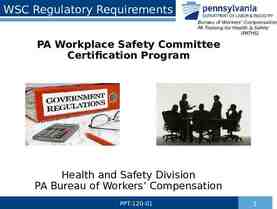H2S Awareness Introduction Hydrogen Sulfide is an extremely toxic
21 Slides1.26 MB
H2S Awareness Introduction Hydrogen Sulfide is an extremely toxic gas that is colorless, flammable, heavier than air, soluble in water, and has the smell of rotten eggs at lower concentrations. At higher concentrations H2S can deaden your sense of smell. H2S
H2S Awareness How Is Hydrogen Sulfide Formed? H2S is a by-product formed when organic matter decays. Hydrogen Sulfide is generated as a common by-product of industrial and manufacturing processes. Hydrogen Sulfide is formed under low oxygen conditions when sufficient amounts of sulfur and bacteria are present. H2S can be formed in many places such as: Oil and gas reservoirs. Sewers and sewage processing facilities. Dark damp places where bacteria is present.
H2S Awareness Where Is Hydrogen Sulfide Found? Hydrogen Sulfide can be found almost anywhere that oil, water, and gas are produced. Examples are: Production Separators Vapor Recovery Units Sulfur Removal Systems Flotation Cells Water Knock-Outs Wellheads or Tanks Heater Treaters Pits, Cellars or Sewers.
H2S Awareness What are the Health Hazards of H2S? Hydrogen Sulfide can have an array of health effects on the body depending on exposure concentrations. H2S will enter through the lungs and is considered a chemical asphyxiate. It blocks the transfer of oxygen to the blood cells and causes paralysis of the respiratory system.
H2S Awareness Exposure Limits Here are the Hydrogen Sulfide (H2S) exposure limits. Permissible Exposure Limit: 10 ppm for an 8-hr period avg. Short Term Exposure Limit: 15 ppm for a 15-minute avg. Immediately Dangerous to Life or Health: 100 ppm
H2S Awareness Concentration Levels & Effects The following table below lists the health effects of exposure to H2S. Concentration Health Effects 10 ppm Beginning eye irritation 50-100 ppm Slight respiratory tract irritation after 1 hour exposure. 100 ppm Coughing, eye irritation, loss of sense of smell after 2-15 minutes. Altered respiration, pain in the eyes, and drowsiness after 15-30 minutes followed by throat irritation after 1 hour. Several hours exposure results in gradual increase in severity of these symptoms and death may occur within the next 48 hours 200-300 ppm 500-700 ppm Severe respiratory tract irritation after 1 hour of exposure. Possible pulmonary edema (fluid in the lungs). Loss of consciousness and possibly death in 30 minutes to 1 hour. 700-1,000 ppm Rapid unconsciousness, loss of respiration, and death after 1-3 minutes. 1,000-2,000ppm Unconsciousness at once, loss of respiration and death in a few minutes. Death may occur even if individual is removed to fresh air at once.
H2S Awareness Monitoring As mentioned, one of Hydrogen Sulfide's effects on the body is it deadens the sense of smell at fairly low concentrations. This can cause a false sense of security and therefore we must use air monitoring equipment to detect H2S. A variety of equipment can be used to do this: Fixed monitors can be located where contamination is possible. Alarms to alert personnel when H2S levels exceed permissible exposure limits. Portable monitors that can be hand held or attached to yourself.
H2S Awareness When Do We Monitor? Air monitoring should be done anytime there is a potential for someone to be exposed over the PEL of H2S. Examples of when air monitoring shall be performed are: At all times when working around H2S concentrations During all confined space entries. Any time there is a potential to be exposed over the PEL. When gauging tanks.
H2S Awareness Escape Guidelines: Should a release occur here are some escape guidelines you must follow. Know the alarm systems. Know where the potential sources for H2S are located. Know the wind direction at all times. Escape by getting upwind to a higher elevation (if possible) from the source. When escaping, always go cross wind and around the source. Never go directly upwind (you may be running into the source).
H2S Awareness Summary: Hydrogen Sulfide is deadly, especially when you don’t understand or respect its dangers. Take H2S seriously follow all safe guidelines and standards. Remember; always ask a supervisor if unsure It’s a matter of life or death.
H2S Awareness Quiz: Short exposure to 100ppm hydrogen sulfide will cause immediate death. False
H2S Awareness Quiz: Hydrogen sulfide is invisible, flammable, explosive and deadly. True
H2S Awareness Quiz: When a hydrogen sulfide emergency occurs, rescue any victims first, then protect yourself. False
H2S Awareness Quiz: Hydrogen sulfide is heavier than air, so it collects in lowlying areas. True
H2S Awareness Quiz: You do not need to worry about H2S unless you detect a rotten-egg odor. False
H2S Awareness Quiz: Emergency escape units can be used to enter and work in H2S environments. False
H2S Awareness Quiz: To avoid exposure to H2S, you should remain “wind conscious”. True
H2S Awareness Quiz: Your breathing apparatus should always be positivepressure, never air-purifying. True
H2S Awareness Quiz: After you’ve been trained to use respiratory protection, you won’t have to worry about additional training. False
H2S Awareness Quiz: If you suspect H2S is present in your work area, you should move immediately downwind away from the area. False


























